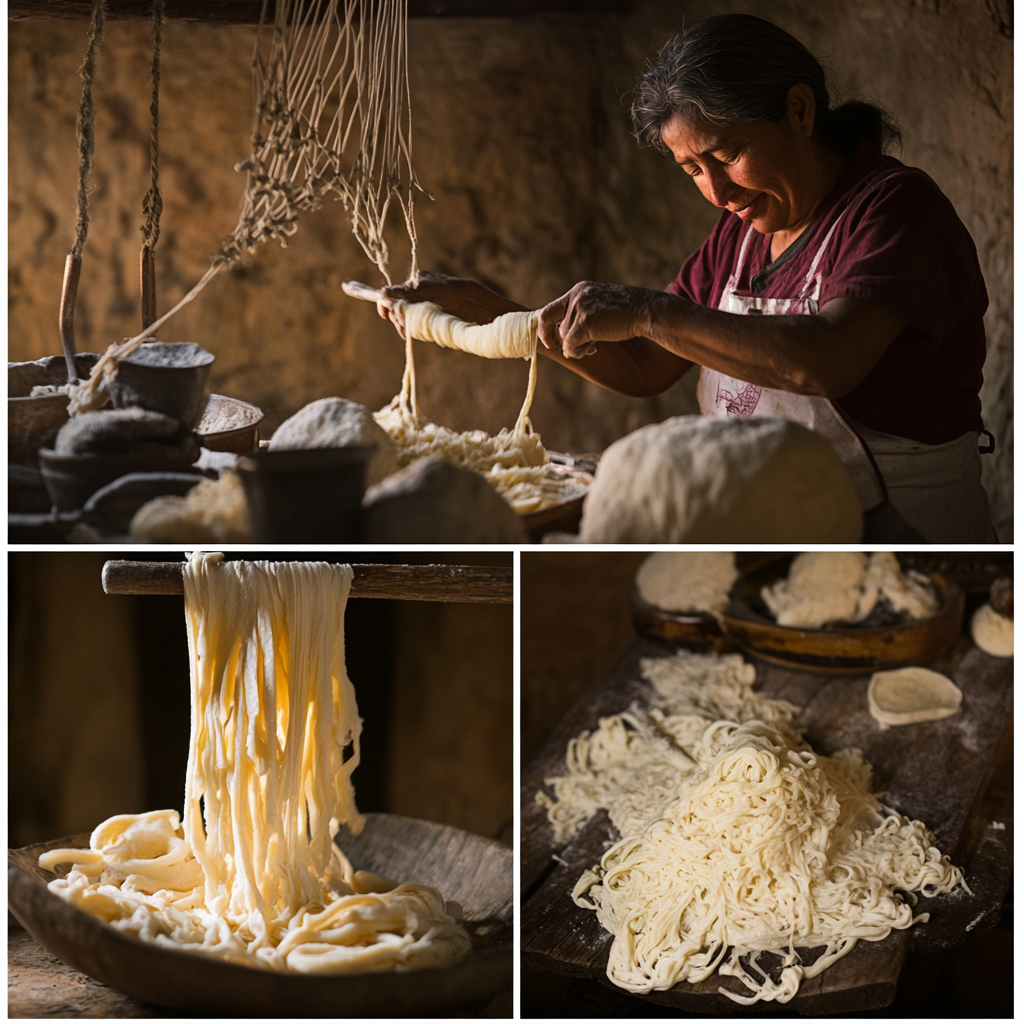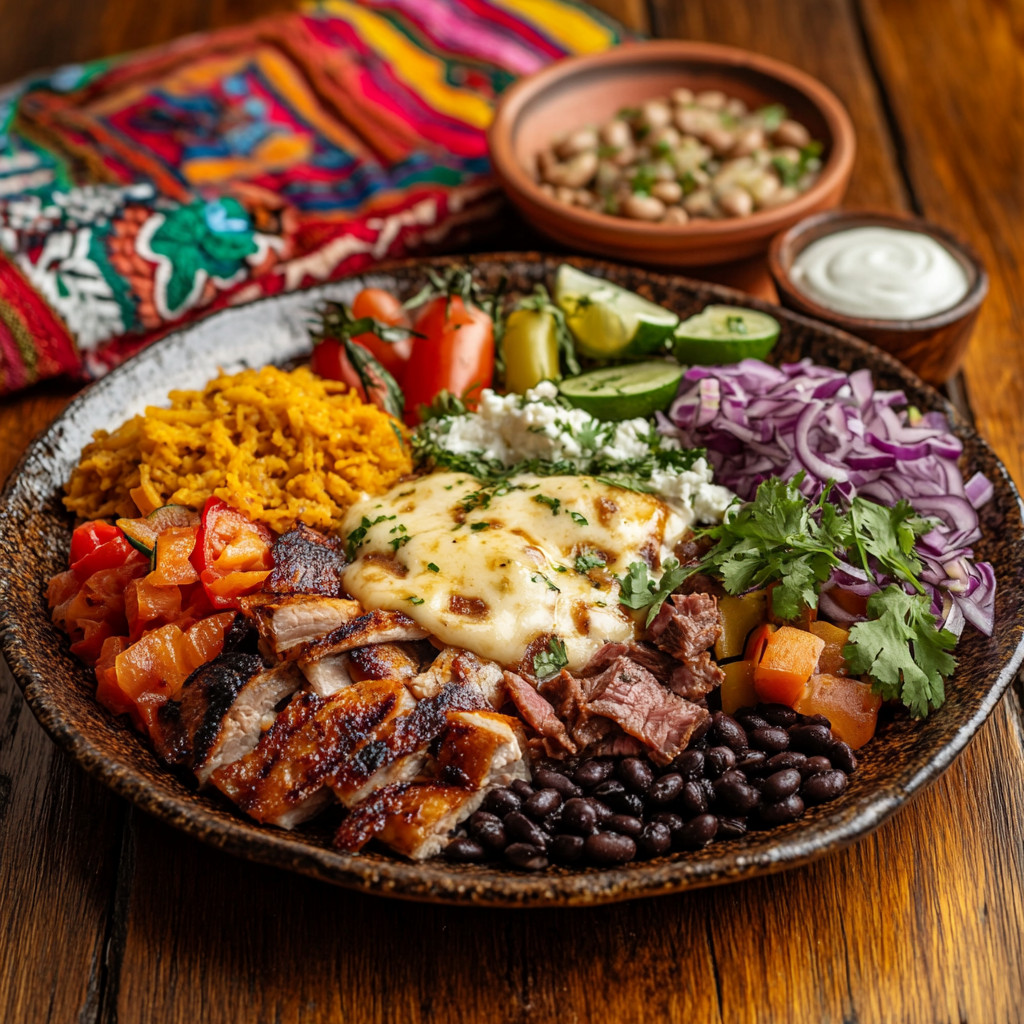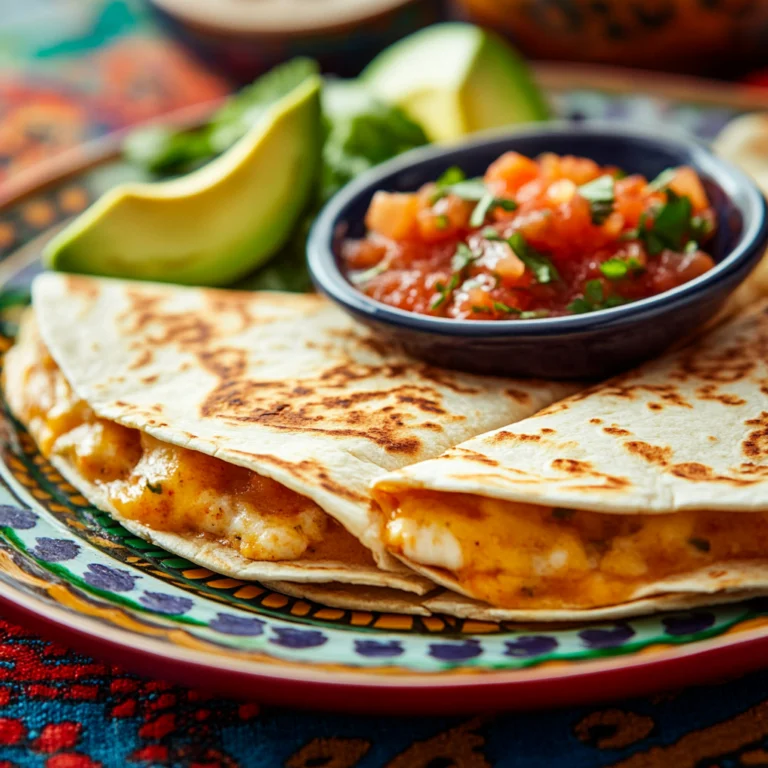What is Quesillo?
Quesillo, often referred to as Oaxaca cheese, is a beloved staple in Mexican cuisine. Originating from the Oaxaca region, this cheese is cherished for its mild, slightly sweet flavor and its distinctive stretchy, stringy texture. Its soft and pliable nature makes it a versatile ingredient, effortlessly enhancing both traditional and modern dishes. For example, recipes like tlayuda showcase its adaptability, blending perfectly with various flavors and textures.
Additionally, quesillo is crafted through a meticulous process involving the kneading and stretching of curd into long ribbons, which are then carefully rolled into balls. As a result of this process, quesillo achieves its distinctive characteristics. Furthermore, its versatility and perfect melting properties have earned it a special place in the kitchens of both home cooks and professional chefs alike.
Why is Quesillo So Popular?
Quesillo’s deep roots in Mexican food culture make it more than just a cheese—it’s a culinary icon. From tacos to traditional chicken breakfast recipes, its versatility elevates a variety of dishes. Its stretchy texture and creamy taste create a harmonious contrast when paired with robust fillings or spicy salsas.
Beyond its culinary applications, quesillo holds cultural significance, as it symbolizes the rich heritage of Oaxaca and the exceptional artistry of its cheesemakers. Over time, its popularity has continued to grow, transcending borders and introducing international food enthusiasts to its unique qualities.
Whether melted in a savory quesadilla, shredded as a topping, or enjoyed on its own, Cottage cheese embodies the very essence of Mexican cuisine. Consequently, it is celebrated for its flavor, versatility, and cultural importance, bringing the vibrant spirit of Mexico into kitchens around the world.
Key Takeaways
- Quesillo, a traditional Mexican string cheese, is celebrated for its mild, slightly sweet flavor and distinctive stretchy texture. This unique cheese originates from the Oaxaca region, where it holds a special place in the culinary traditions of the area.
- Deeply rooted in Mexican food culture, quesillo’s versatility makes it a staple ingredient in a wide variety of traditional dishes. From quesadillas to tlayudas, and even enchiladas, its creamy taste and perfect melting properties enhance the flavor and texture of these beloved recipes. This adaptability has significantly contributed to its widespread popularity across Mexico and beyond.
- The artisanal production of Cottage cheese is another hallmark of its appeal. Crafted through a meticulous process of kneading and stretching curds into long ribbons, which are then rolled into balls, Cottage cheese achieves its characteristic stringy texture and pliability. These unique qualities, combined with its rich cultural heritage, have made it an iconic symbol of Mexican gastronomy worldwide.
- Quesillo is more than just a cheese—it represents the essence of Oaxaca’s culinary artistry and the vibrant traditions of Mexican cuisine. Its cultural significance, coupled with its gastronomic appeal, has solidified its place as a cherished ingredient in Mexico’s diverse and dynamic food culture. Loved by locals and international food enthusiasts alike, Cottage cheese continues to bring a taste of authentic Mexico to tables around the globe.
- Whether in a timeless quesadilla or an innovative breakfast bowl, Cottage cheese embodies the spirit of Mexican cuisine. Loved for its flavor, texture, and cultural roots, it remains a cherished ingredient in kitchens around the world, blending tradition with modern flair.
Understanding Quesillo: The Iconic Mexican String Cheese

Quesillo, the traditional Mexican cheese, comes from the Oaxaca region. It’s a favorite in Hispanic cuisine. It shows the rich food traditions of Mexico.
Origins in Oaxaca Region
The story of quesillo starts in Oaxaca’s south. For centuries, the cheese has been made here. The area’s climate and dairy ways helped shape its taste and feel.
Cultural Significance in Mexican Cuisine
Quesillo is key in traditional Mexican recipes. It’s used in many dishes, from tacos to desserts. Its soft texture and mild flavor are loved for everyday meals and special events.
Distinguishing Features of Authentic Quesillo
- Stringy Texture: Real quesillo has long, easy-to-pull strands. This gives it a special feel in your mouth.
- Mild Flavor: Oaxaca cheese tastes mild and slightly salty. It pairs well with many foods without being too strong.
- Traditional Production Methods: Cottage cheese is made the old way. This keeps its true taste and quality alive.
| Characteristic | Description |
|---|---|
| Texture | Stringy, with long, stretchy strands |
| Flavor | Mild, slightly salty taste |
| Production | Traditional, artisanal methods |
The Traditional Process of Making Quesillo
The Art of Making Quesillo: A Timeless Craft
Making quesillo, Mexico’s renowned string cheese, is a treasured tradition that has been passed down through generations. This intricate process demands a combination of skill, patience, and dedication, resulting in the cheese’s signature stretchy texture and mild flavor.
The journey starts with fresh, high-quality milk, the key to quesillo’s exceptional taste. To begin the transformation, a natural enzyme called rennet is added, causing the milk to curdle. This step separates the solids (curds) from the liquid whey, setting the stage for the creation of quesillo’s characteristic stringy strands.
Crafting the Perfect Texture
Once the curds have formed, they are carefully heated and kneaded—a step requiring precision and expertise. This delicate handling ensures the curds reach the ideal consistency for stretching. Gradually, the kneading transforms the curds into a pliable mass, which is then stretched and folded multiple times. It is during this phase that quesillo’s iconic strands emerge, creating the signature “string cheese” texture loved by many.
When the cheese achieves the perfect balance of elasticity and stretchiness, it is shaped into traditional cylindrical rolls or blocks. At this point, quesillo is ready to enhance a variety of dishes—melted in quesadillas, shredded as a topping, or simply enjoyed on its own.
A Culinary Treasure
Every step in quesillo’s production reflects the rich cultural heritage and artisanal craftsmanship of Oaxaca. The care and tradition infused into its making are what elevate Cottage cheese above other cheeses. From its beginnings as fresh milk to its final form as a culinary masterpiece, quesillo embodies the essence of Mexican culture and quality. It continues to be cherished by cheese enthusiasts worldwide, celebrating the flavors and traditions of Mexico with every bite.
Nutritional Benefits and Composition
Quesillo, the traditional Mexican string cheese, is loved by many. It’s not just a favorite food but also packed with nutrients. It’s a great source of protein and calcium, making it good for your diet.
Protein and Calcium Content
Quesillo has about 6 grams of protein per ounce. This is as much as or more than other Mexican cheeses. It’s also full of calcium, with 200 milligrams per ounce. This is important for strong bones and teeth.
Comparison with Other Mexican Cheeses
| Cheese | Protein (g/oz) | Calcium (mg/oz) |
|---|---|---|
| Quesillo | 6 | 200 |
| Queso Fresco | 4 | 150 |
| Cotija | 7 | 180 |
| Oaxaca | 5 | 190 |
Dietary Considerations
Quesillo is an excellent option for individuals with lactose intolerance, thanks to its fermentation process, which reduces lactose levels significantly. This traditional Mexican string cheese is also relatively low in fat and calories, making it a nutritious addition to a balanced diet. Packed with protein and essential nutrients like calcium, Cottage cheese supports bone health and muscle development. Its mild flavor and stretchy texture make it a versatile ingredient in various dishes, allowing you to enjoy both taste and nutrition. Consuming quesillo in moderation not only enhances your meals but can also contribute to overall health and well-being. Embrace this wholesome cheese as a delicious way to maintain a healthy lifestyle while savoring authentic Mexican flavors.
Popular Culinary Applications and Recipes
The Versatility of Quesillo in Traditional Dishes
Quesillo, the iconic Mexican string cheese, is a beloved staple in Hispanic cuisine, celebrated for its rich, creamy texture and excellent melting properties. It is a key ingredient in numerous traditional dishes, enhancing both flavor and texture.
One of the most well-known uses of quesillo is in the classic quesadilla. Sandwiched between two tortillas and melted to perfection, quesillo creates a warm, gooey snack or meal that’s both simple and satisfying. Another traditional favorite is the tlayuda, a large, crispy tortilla topped with beans, meats, and vegetables, with quesillo as the star ingredient, adding its signature stretchiness and mild flavor.
In enchiladas, quesillo truly shines, used either as a filling or as a topping. Its ability to melt seamlessly complements the rich sauces and tender tortillas, bringing harmony to every bite. These traditional dishes highlight quesillo’s importance in preserving the culinary heritage of Mexico.
Quesillo in Modern Culinary Creations

Beyond its role in traditional recipes, quesillo also finds a place in modern, Mexican-inspired dishes. Its versatility makes it perfect for innovative culinary creations. It can elevate a gourmet grilled cheese sandwich, adding a uniquely Mexican twist with its creamy and stringy texture. Quesillo also works wonderfully as a topping for nachos or tostadas, providing a deliciously melted layer that binds the ingredients together.
Whether in a timeless tlayuda or a contemporary snack, quesillo offers endless opportunities for culinary creativity. Its ability to blend tradition with modern flair ensures that it remains a cherished ingredient, beloved by chefs and home cooks alike. From classic comfort foods to inventive new recipes, quesillo continues to bring people together through its exceptional flavor and versatility.
| Dish | Description |
|---|---|
| Quesadillas | Melted quesillo sandwiched between two tortillas |
| Tlayuda | Large, crispy tortilla topped with quesillo, beans, meat, and other ingredients |
| Enchiladas | Quesillo used as a filling or topping, melting into the other components |
| Grilled Cheese Sandwiches | Quesillo incorporated into contemporary Mexican-inspired recipes |
| Nachos and Tostadas | Quesillo used as a topping, adding its signature melting properties |
From classic Mexican dishes to innovative culinary creations, quesillo’s versatility and unique melting characteristics make it an indispensable ingredient in the rich tapestry of Hispanic cuisine.
Buying and Storing Tips for Fresh Quesillo
How to Select and Store Quesillo for Maximum Freshness
Quesillo, the iconic Mexican string cheese, is a beloved dairy product known for its mild flavor and stretchy texture. To ensure you enjoy its best quality, it’s important to choose and store it properly. These simple tips will help you maintain the freshness and flavor of this versatile cheese.
Selection Tips: Picking the Perfect Quesillo
When purchasing quesillo, start by inspecting the packaging. Look for tightly sealed packages that protect the cheese from exposure to air. The cheese itself should be creamy white with a soft, pliable texture, free of any dryness or crumbling. Avoid quesillo with visible mold, discoloration, or signs of spoilage, as these are indicators that the cheese is no longer fresh.
Fresh quesillo should have a subtle, pleasant aroma and a slightly sweet flavor. Taking the time to choose a high-quality product ensures a better experience when incorporating it into your favorite dishes.
Storage Tips: Keeping Your Quesillo Fresh
Proper storage is key to maintaining the quality of quesillo. Keep the cheese in its original packaging or wrap it tightly in an airtight container to prevent exposure to air and moisture. Store it in the refrigerator at a temperature between 35°F and 40°F, as this helps retain its texture and prevents it from drying out.
Shelf Life and Spoilage Indicators
Under proper storage conditions, quesillo typically lasts up to two weeks. However, it’s important to monitor for signs of spoilage, such as a sour or unpleasant odor, discoloration, or a slimy texture. If you notice any of these issues, discard the cheese immediately to avoid food safety risks.
By selecting high-quality quesillo and storing it properly, you’ll always have fresh, flavorful cheese on hand to elevate your Mexican culinary creations.
Conclusion
In our journey into quesillo, we’ve seen its deep cultural meaning and cooking uses. This Mexican cheese comes from the lively Oaxaca region. It’s loved in Hispanic cuisine and enjoyed by people all over.
Quesillo’s special texture and taste show the skill of Mexican cheese-making. It’s not just a food; it’s a part of Mexican traditions. Enjoying quesillo lets us connect with its rich culture and the importance of keeping these foods alive.
If you love cheese or are new to quesillo, try it out. Use it in different dishes and learn about its cultural value. You’ll enjoy its unique tastes and textures. This way, you’ll also grow to love the traditions of Hispanic cuisine even more.
FAQ
What is quesillo?
Quesillo is a traditional Mexican string cheese from the Oaxaca region. It has a mild flavor and a stretchy texture. It’s very versatile in Mexican cooking.
What are the distinguishing features of authentic quesillo?
Real quesillo has a stringy, elastic texture and a mild, slightly salty taste. It melts well, which makes it great in many Mexican dishes.
How is quesillo traditionally made?
Making quesillo the old way starts with curdling milk. Then, the curds are stretched and shaped. Finally, the cheese is stored to get its unique texture and flavor. This process takes skill and patience.
What are the nutritional benefits of quesillo?
Quesillo is rich in protein and calcium. It also has less lactose, which is good for those with lactose intolerance.
How is quesillo commonly used in Mexican cuisine?
Quesillo is used in many traditional Mexican dishes. It’s great in quesadillas, tlayudas, and enchiladas. Its melting quality adds flavor and texture to these dishes.
How should quesillo be stored and handled?
Keep quesillo fresh by storing it in the fridge, wrapped in plastic or cheesecloth. Always check the cheese for any signs of spoilage before using it.

